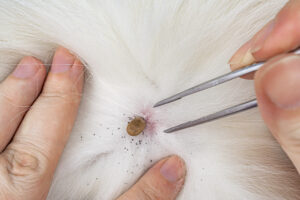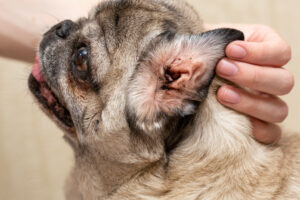
For paw-parents there is constant list of things to look out for when it comes to pooches. Today we’re diving into a topic that’s as pesky as a fly at a picnic—ticks and mites!
While these little critters might be small, they can cause big problems for our furry friends. But fear not armed with knowledge and a dash of love, we can keep our pups safe and comfortable.
What Are Ticks and Mites?
Ticks are spider-like small parasites that suck blood from other animals. They have eight legs with an oval body that darkens as it fills with blood. These pests don’t fly or jump but instead climb or land on your dog.
Mites are tiny creatures with a hard exterior, these parasites look like teeny tiny black dots on your pup’s skin but can cause great irritation.
How will Ticks and Mites affect your four-legged friend?
- Ticks: These little parasites latch onto your dog’s skin, sucking blood and potentially transmitting diseases. Their bite might seem like a minor nuisance, but in some cases, it can lead to serious health issues.
- Mites: From causing that relentless itch to leading to skin infections, mites are another common culprit behind canine discomfort. Some mites, like the ones causing mange, can make your pup’s coat less fluffy and their skin sore.
How to spot signs your dog has these unwanted visitors.
- Excessive Scratching and Biting: If your pup is constantly licking or scratching a particular spot, it might be trying to tell you something.
- Red, Irritated Skin: Look out for bumps, scabs, or redness, especially around the ears, neck, or legs.
- Hair loss.
- Head shaking.
- Scabs and open sores.
- Excessive licking.
- Ear discharge.
- Dry, flaky skin.
- Visible Pests: With a little patience and a close look, you might even spot a tick or notice the tell tale signs of mite infestations.
If you are unsure if your furry-friend has ticks or mites, please consult your veterinary practice who will be able to offer further guidance.
Preventing a Pesky Problem
Prevention is always better than cure—especially when it comes to ticks and mites!
- Regular Grooming: A well-groomed dog is less likely to harbour these pests. Brush your dog’s coat often and check for any unwanted guests.
- Tick Preventatives: There are plenty of safe, vet-approved treatments available that repel or kill ticks and mites before they become a problem.
- Garden Maintenance: Keep outdoor areas trimmed and clear of tall grass to reduce the likelihood of encounters with ticks.
- Frequent Check-Ups: Regular visits to your vet can help catch any issues early, ensuring your pup stays itch-free and happy.
What To Do If You Find Ticks or Mites
Finding a tick or noticing signs of mites can be a bit alarming but stay calm!
- Tick Removal: Use a fine-tipped tweezer to grasp the tick as close to your dog’s skin as possible, then gently twist and pull it out. If you’re unsure, ask your vet for help! Why not offer a Laughing Dog treat for being a brave pup
- Mite Treatment: Your veterinarian can recommend the best treatment plan, which might include medicated shampoos or topical treatments.
- Keep It Clean: If you’re dealing with mites, keeping your dog’s bedding and favourite blankets clean can prevent re-infestation.
Ticks and mites might be tiny, but they can cause a big fuss if left unchecked. With a little vigilance, regular grooming, and the right preventative measures, you can keep your dog’s skin as soft and pest free. Remember, every cuddle and wag of the tail is worth the effort to keep our four-legged friends comfortable and healthy.
We recommend consulting your vet to ensure any preventative measures or treatments are suitable for your four-legged friends individual needs.





